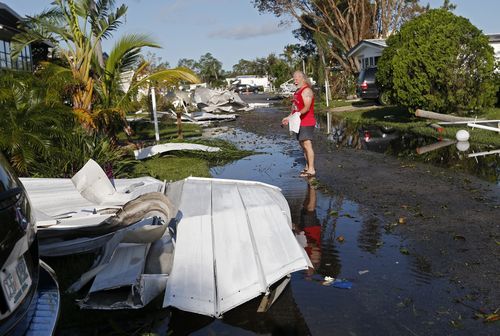[dropcap]E[/dropcap]xperts expect homeowners and auto insurance premiums to go up in the aftermath of hurricanes Harvey and Irma.(Photo: Gerald Herbert, AP)
You may not live in one of the areas hit by hurricanes Harvey and Irma, but that doesn’t mean your insurance rates will go unscathed.
Get ready for a reality check! Experts say the damage caused by Hurricane Harvey and Hurricane Irma mean higher insurance costs for most Americans. USA TODAY
Motorists and homeowners throughout Texas and Florida as well as those who live anywhere from Alabama to Wyoming could see their premiums rise, as insurance companies pay out billions of dollars to customers whose properties were destroyed or damaged. For example, hurricane winds could damage your roof or flip over your car.
The estimated U.S. insured losses, excluding any National Flood Insurance Program claims, are $20 billion to $25 billion from Harvey and $40 billion to $60 billion from Irma, according to JLT Re, a global reinsurance brokerage and consulting firm.
Experts say insurers are looking to stay flush as they cover their reinsurance policies — which keep them insured and able to mitigate risk — while trying to prepare for any extreme future weather that could harm their customers.
“There’s an increased perception of risk. There’s less capital supporting the insurance industry, and there’s equal demand,” says David Havens, managing director of investment bank Imperial Capital.
“The way insurers respond to that is to raise prices, because they need to replenish.”
People living in the areas slammed by the hurricanes are most at risk for auto and homeowners rate increases.
But because insurance is handled by each state individually, people elsewhere in Texas and Florida could see a bump, too. Drivers in states adjacent to those Harvey and Irma hammered also may face rate hikes, because some insurers calculate car insurance rates regionally.
Insurers can’t jack up premiums in random states to make up for large payouts to Harvey and Irma victims. But a ripple effect can happen.
“They can’t go to Nevada and say, ‘We need to raise rates here because of money in Texas.’
They could say, ‘We’ve lost so much in Texas that we don’t want to write as much business in Nevada,’ ” Havens says.
There’s $1.3 trillion in capital ready to support these losses, according to Havens.
It’s too early to know how much Harvey and Irma could raise rates. But an analysis of average insurance premiums in states hit by some of the costliest hurricanes in U.S. history shows what could happen. For example:
- New Jersey homeowner: $926 in 2011, the year before Hurricane Sandy. $1,068 in 2013, the year after.
- New York motorist: $1,108.64 in 2011. $1,181.86 in 2013.
- Mississippi homeowner: $860.66 in 2004, the year before Hurricane Katrina. $969 in 2006, the year after.
- Louisiana motorist: $1,228.10 in 2004. $1,254.66 in 2006.
When Kyle Parry returned to his home in Lumberton, Texas, after Hurricane Harvey hit, it was a complete loss. Everything was under water, except one very special thing.
Wochit
The higher dollar amounts can’t be blamed solely on extreme weather; insurance premiums can go up for a variety of reasons, experts say.
Replacement costs of destroyed homes may be larger because of elevated construction and labor costs, for instance, and distracted-driving across the United States contributes to auto insurance premium hikes.
Insurance companies’ concerns over their own cash flows also stem from the long, low-interest environment which has limited the returns on their investments, CFRA insurance equity analyst Cathy Seifert explained.
More: Hurricane Irma: Worst-case scenario not happening and insurance sector soars
More: After Hurricanes Harvey, Irma: Tips for filing an insurance claim
More: Proposal would allow Harvey victims to use retirement savings for home repair
Because of Harvey and Irma, she anticipates reinsurance rates rising, prompting insurance companies to pass along those costs to ordinary Americans.
The American Insurance Association, the trade group for the property-casualty insurance industry, said it’s too early to know if rates will rise.
Actuaries will rely on meteorological models and probability predictions to calculate how much it’ll be to cover losses.
“It’s not a recoupment mechanism; it’s not about setting premiums to offset last year’s policies,” says Mike O’Malley, senior vice president of public policy for the association.
Because of insurers’ preparation for extreme weather and the competitive nature of the insurance marketplace, Ted Nickel, president of the National Association of Insurance Commissioners, isn’t forecasting higher insurance costs for consumers either.
“These companies would’ve built up a surplus with their modeling to be ready for their big event whether it occurred 10 years ago or this week,” he explains.
“These catastrophes are built into their pricing. Will it be zero? I don’t know. I wouldn’t want someone in West Texas to subsidize my insurance in Houston.”
Follow USA TODAY reporter Zlati Meyer on Twitter: @ZlatiMeyer
